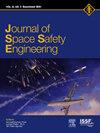AstroLibrary: A library for real-time conjunction assessment and optimal collision avoidance
IF 1.7
Q3 ENGINEERING, AEROSPACE
引用次数: 0
Abstract
Geospace is crowded due to the proliferation of satellites and space debris and will become more crowded with the increasing deployment of new space missions. This trend is rapidly increasing the probability of collisions between space objects. Space objects fly at extreme speeds; hence, the consequences of collisions are catastrophic. However, accurate and efficient conjunction assessment (CA) and collision avoidance (COLA) have long been challenging, even with the current space catalogues of O(104) size. As the space catalogue size increases owing to the increased number of new satellites, improved sensor capabilities, and Kessler syndrome, the situation will worsen unless a paradigm-transforming computational method is devised. Here, we present the SpaceMap method, which can perform real-time CA and near-real-time COLA for O(106) or more objects, provided that the spatiotemporal proximity amongst satellites is represented in a Voronoi diagram. As the most concise and efficient data structure for spatiotemporal reasoning amongst moving objects, Voronoi diagrams play a key role in the mathematical and computational basis for a new genre of artificial intelligence (AI) called space–time AI, which can find the best solutions to CA/COLA and other space decision-making problems in longer timeline windows. The algorithms are implemented in C++ and are available on GitHub as AstroLibrary, which has RESTful APIs and Python packages that can be called from application programs. Using this library, anyone with elementary programming skills can easily develop efficient applications for challenging spatiotemporal problems.
AstroLibrary:用于实时会合评估和优化避免碰撞的图书馆
由于卫星和空间碎片的激增,地球空间变得十分拥挤,而且随着新的空间飞行任务的不断部署,地球空间将变得更加拥挤。这一趋势正在迅速增加空间物体之间发生碰撞的概率。空间物体的飞行速度极快,因此碰撞的后果是灾难性的。然而,长期以来,精确高效的会合评估(CA)和碰撞避免(COLA)一直是一项挑战,即使是在当前 O(104)大小的空间目录中也是如此。随着新卫星数量的增加、传感器能力的提高以及凯斯勒综合征(Kessler Syndrome)的出现,空间目录的规模也在不断扩大,除非设计出一种能改变模式的计算方法,否则情况将会恶化。在此,我们提出了 SpaceMap 方法,该方法可以对 O(106) 或更多的对象执行实时 CA 和近实时 COLA,前提是卫星之间的时空接近性用 Voronoi 图表示。作为移动物体间时空推理最简洁、最高效的数据结构,Voronoi 图在被称为时空人工智能(space-time AI)的人工智能(AI)新流派的数学和计算基础中发挥着关键作用,它能在更长的时间窗口内找到 CA/COLA 和其他空间决策问题的最佳解决方案。这些算法是用 C++ 实现的,并以 AstroLibrary 的形式发布在 GitHub 上,它有 RESTful API 和 Python 包,可以从应用程序中调用。利用这个库,任何具备初级编程技巧的人都能轻松开发出高效的应用程序,解决具有挑战性的时空问题。
本文章由计算机程序翻译,如有差异,请以英文原文为准。
求助全文
约1分钟内获得全文
求助全文
来源期刊

Journal of Space Safety Engineering
Engineering-Safety, Risk, Reliability and Quality
CiteScore
2.50
自引率
0.00%
发文量
80
 求助内容:
求助内容: 应助结果提醒方式:
应助结果提醒方式:


